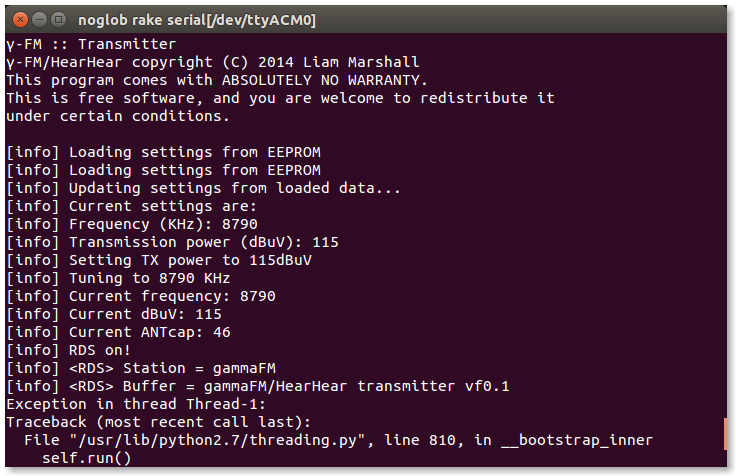-
PCBs for γ-FM transmitter assembled and working
12/13/2014 at 17:58 • 0 commentsSuper cool to see my code running on a board I made:
![]()
The exception was miniterm.py freaking out when I unplugged the board :)
-
Progress update
12/07/2014 at 00:51 • 0 commentsThis Christmas, I'm working on a new FM-based system, and PCBs for it.
Most of the files are under the vf0.1 headingI've also been working on Stirrup, a new firmware for that system.
I'll be putting up some pictures soon too.
-
System Design Document
08/20/2014 at 22:55 • 0 commentsKnocked together from what's in my head. It'll be updated later.
![]()
-
Moving Cochlea to Arduino (powered by Ino) and various updates
08/20/2014 at 21:15 • 0 commentsWell, it turns out that the BC127 library was beyond my skills to port in a small amount of time to plain C.
Thus I've moved to Arduino, and dropped the Arduino IDE in favor of Ino.
Development is commencing today. ISRs will be assigned soon, as well as pins. Board layout is nearly done, with only the headphone amp to route. The system design document will be finished today, as well as the video.
-
Moving along with firmware
08/18/2014 at 21:48 • 0 commentsHey all,
Cochlea's progressing pretty quickly right now.
I've got some pretty cool stuff planned, including bare C(++) BC127 libraries.See what I've done and not done (yet) on my Waffle board.
-
The Cochlea Firmware
08/16/2014 at 18:31 • 0 commentsAttributions
The Cochlea firmware is configured and built with Antares. The standard functions are provided by AVR Libc. It is compiled with avrgcc. Serial libraries are courtesy of Nekromant/Antares. BC127 libraries are adapted to plain AVR C from Sparkfun's BC127 library.
The Firmware Design
The firmware simply searches for transmitters in range and pairs to the first found, and then requests new audio. The status from the firmware is outputted on an LED near a button controlling most firmware functions.
By pressing the button, the audio is muted both on the BC127 and on the headphone amp (which reduces hiss). The button triggers an ISR to do this. While the button is muted, the LED will fade in and out.
On the side of the device, a Volume+ and Volume- button exist. They are wired such that each button triggers an interrupt which checks to see which button is pressed. Upon doing so, the BC127's volume is modified.
-
Design, and why I haven't posted for a while
07/11/2014 at 16:25 • 0 commentsFirst of all, sorry I haven't posted for so long: I've been working with MAYDAY.US, and working on my Mendel90, so I haven't had much time to work on this.
But I thought I'd let people know that I've worked out *generally* how the units will look and work.
The receiver
The receiver will be a little larger than a Square credit card reader, as I said before.
Here's a picture of a Square reader, if you haven't seen one before:![]()
The credit-card accepting side will be closed, obviously, and the headphones will plug in where the TRRS jack sticks out in the Square reader. If anyone knows of 3d models of Square devices, post them in the comments below.
The "square" in the centre of the top will be a button with a RGB LED behind to signal status.
The transmitter
The transmitter will be fairly large, in fact larger than it needs to be, about the size of a WRT54G router.
The reason for this is that it's going to sit in the TV cabinet, it needs to be large and heavy enough to counteract the torsion of the cables connecting to it.Very little of the inside space will be used, the front panel, and connector/transmitter PCBs will be separate, with ribbon cable connecting the front to the back.
The lights on the front will be such as power, paired, that sort of thing.
And what's the point of this post?
Because I need to know around what size I'm aiming for to be able to better understand constraints, positioning, etc.
-
FM radio α version of Hear Hear
05/21/2014 at 20:00 • 0 commentsAs an α-test for user interface design, I knocked up a transmitter and reciever using the NS73M FM transmitter and the Si4703 FM tuner.
Ahh, ugly cardboard boxes. I can't wait to be rid of thee ;)
It worked well; I alpha tested it on Star Wars ;)
The volume knob was a *bit* strange, gave the illusion of analog sensitivity *but* only had 16 levels.
The mute button works well; but the horrendous flashing of the power light when it's muted has to go.
Same with the debugging startup flashes. And *never* use a 10mm led on anything that's going to be used in a darkened room that should stay dark ;)
 Liam Marshall
Liam Marshall

